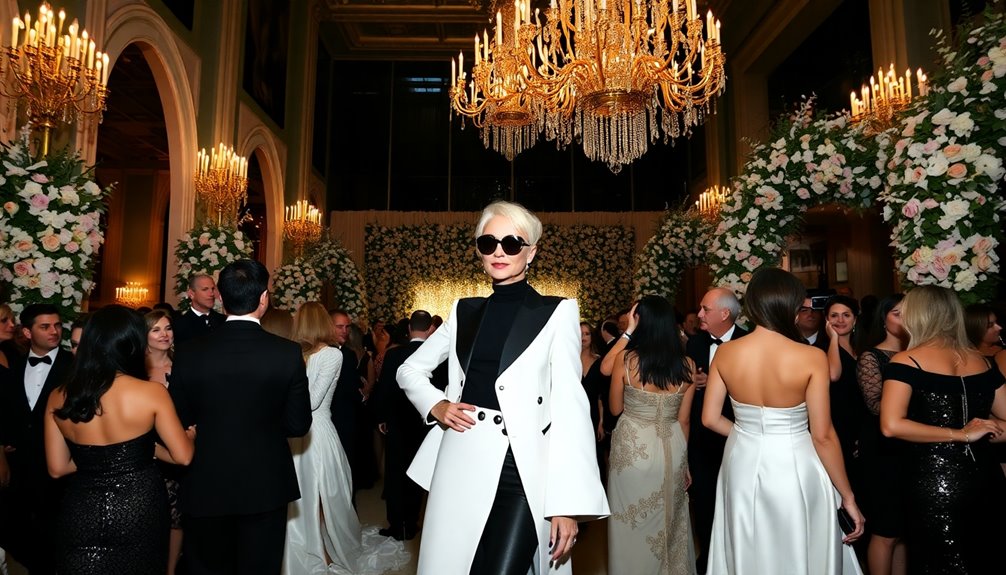Vogue covers have been pivotal in defining fashion history since 1892, showcasing everything from high society to inclusivity. You'll notice how the introduction of supermodels in the 1990s transformed beauty perceptions, while pioneering models like Donyale Luna broke barriers in representation. Recent covers push boundaries, celebrating gender fluidity and diverse identities. Each cover reflects not just style trends but also cultural shifts, connecting fashion to societal values. As you explore more, you'll uncover how these iconic images continue to influence today's fashion landscape and challenge the norms we used to know.
Key Takeaways
- The first issue of Vogue in 1892 featured a debutante, establishing its focus on elite society and luxury fashion.
- Donyale Luna's 1966 cover was groundbreaking as the first Black model on British Vogue, promoting diversity in fashion representation.
- The 1990s supermodel covers highlighted natural beauty and inclusivity, reflecting a cultural shift towards broader beauty standards.
- Anna Wintour's leadership redefined cover aesthetics by blending high fashion with accessible styles, influencing global fashion trends.
- Recent covers embracing gender fluidity challenge traditional beauty norms, signifying Vogue's commitment to evolving cultural conversations in fashion.
Historical Milestones in Vogue
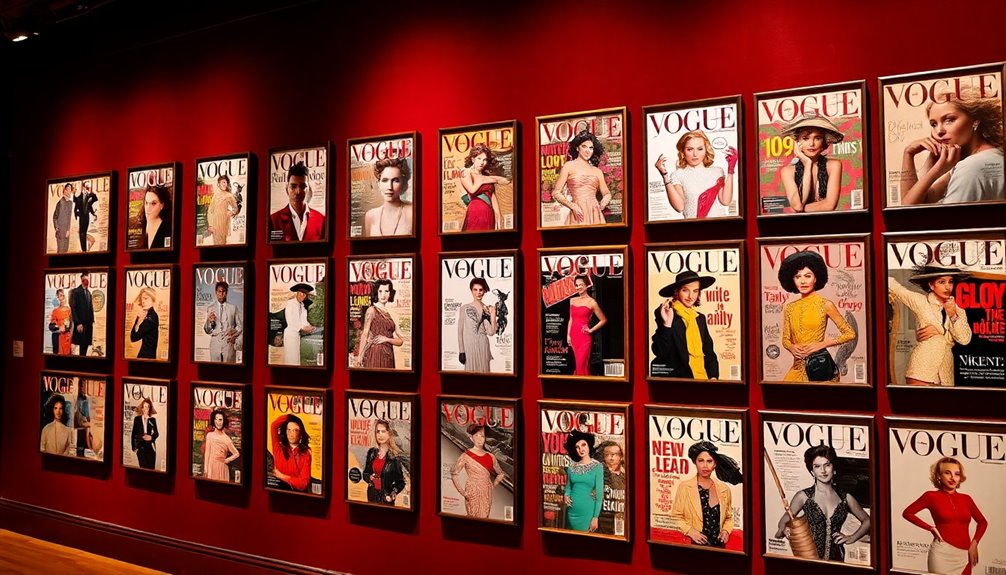
Vogue has marked numerous historical milestones since its inception, with its first issue cover published on December 17, 1892. Founded by Arthur Baldwin Turnure, it targeted New York's upper class, costing just 10 cents—around $3.39 today.
The debut cover featured a debutante, celebrating the ceremonial life of elite society. Over time, Vogue evolved from hand-drawn illustrations to photography, greatly shifting fashion journalism.
This change not only transformed the magazine's aesthetic but also reflected changes in society's perception of fashion. As each cover told a unique story, it captured the essence of the era, setting the stage for Vogue's longstanding influence in the fashion sector.
You can see how these milestones shaped the industry and defined cultural moments.
Pioneering Models and Representation
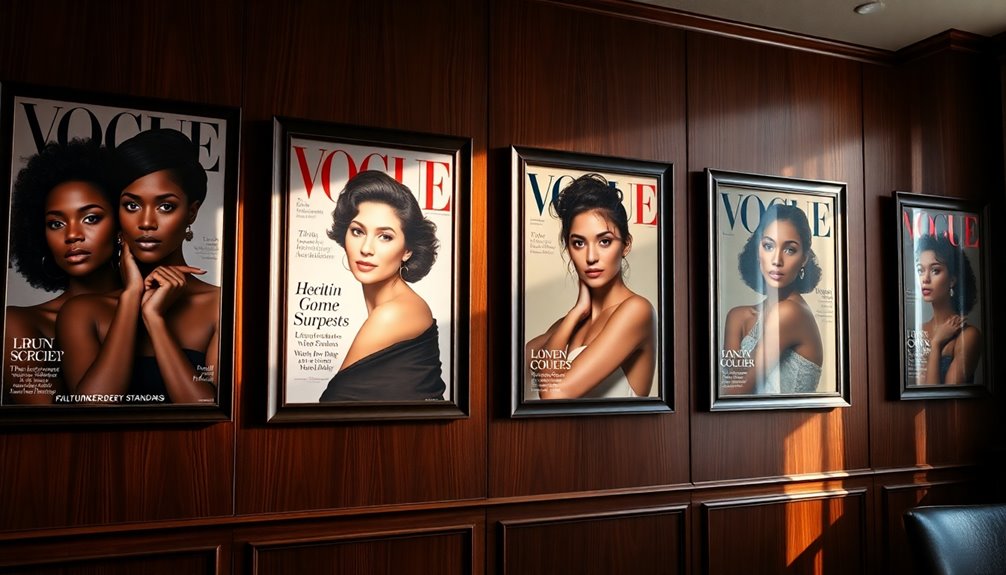
Throughout its history, Vogue has showcased numerous pioneering models who broke barriers and reshaped the industry. You can't overlook Donyale Luna, who became the first Black model on British Vogue's cover in 1966, paving the way for future generations.
Similarly, Audrey Hepburn's 1959 cover defined elegance and sophistication, influencing fashion standards with her timeless style. Iconic figures like Twiggy, Naomi Campbell, and Kate Moss didn't just grace the pages; they challenged beauty norms and cultural perceptions.
Each of these models represented significant moments in fashion, sparking conversations about diversity and inclusivity. Their contributions helped Vogue evolve into a platform that celebrates varied identities, making strides toward a more representative and inclusive industry.
Evolution of Vogue Covers
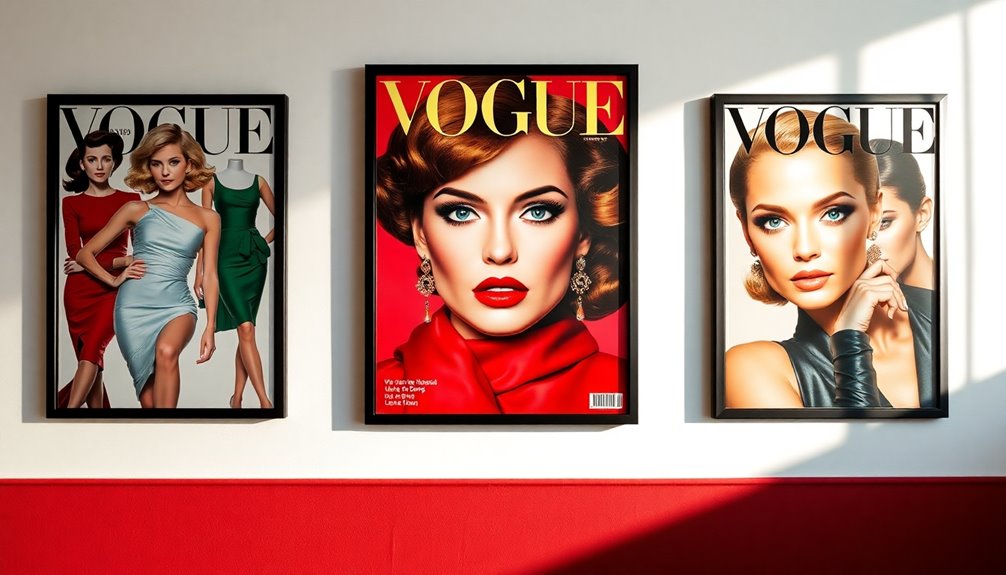
The evolution of Vogue covers reflects the dynamic shifts in fashion and societal norms over the decades. You can see how they changed from hand-drawn illustrations, which celebrated elite social gatherings, to striking photography that captures diverse stories.
As you explore various issues, you'll notice how covers began to incorporate a broader range of models and themes, mirroring cultural changes.
- Early covers emphasized luxury and exclusivity, often depicting high society.
- The 1990s introduced supermodels, highlighting natural beauty and inclusivity.
- Recent covers celebrate gender fluidity and challenge traditional fashion norms.
Each era of Vogue covers tells a story, showcasing the magazine's ability to adapt and resonate with its audience through visual narratives.
Cultural Impact and Identity
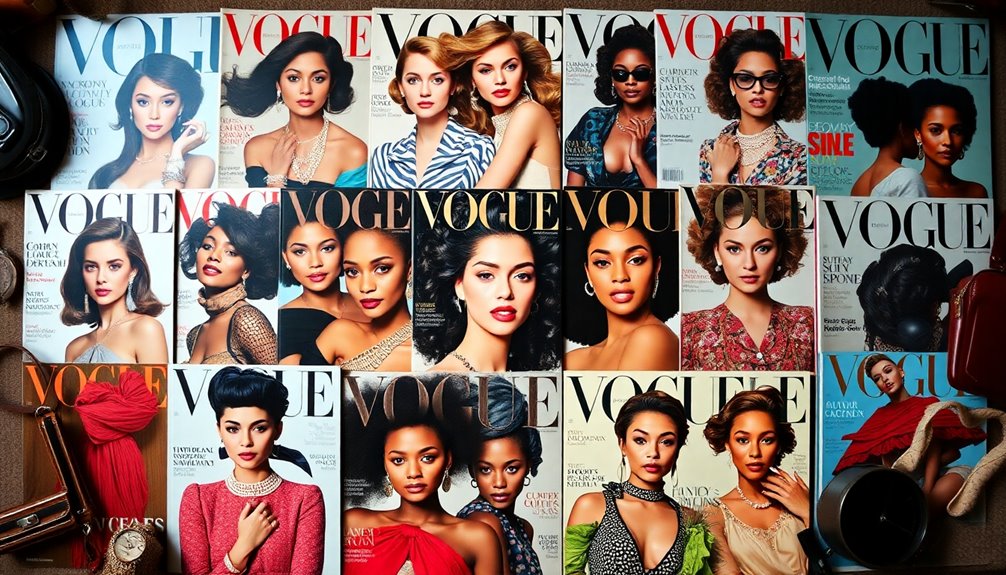
Fashion's cultural impact extends far beyond mere aesthetics; it shapes identities and reflects societal values. When you flip through Vogue covers, you see more than just clothing; you witness a visual narrative of changing times. Each cover captures significant cultural shifts, from diversity to political movements, sparking conversations around inclusivity.
Supermodels, often featured prominently, transcend fashion to become cultural icons, influencing music and film while reshaping beauty standards. By engaging with pressing social issues, Vogue fosters a deeper connection between fashion and identity, allowing you to explore and express your own sense of self.
Through its pages, you not only find inspiration but also a mirror reflecting the evolving landscape of society and culture.
Gender and Fashion Norms
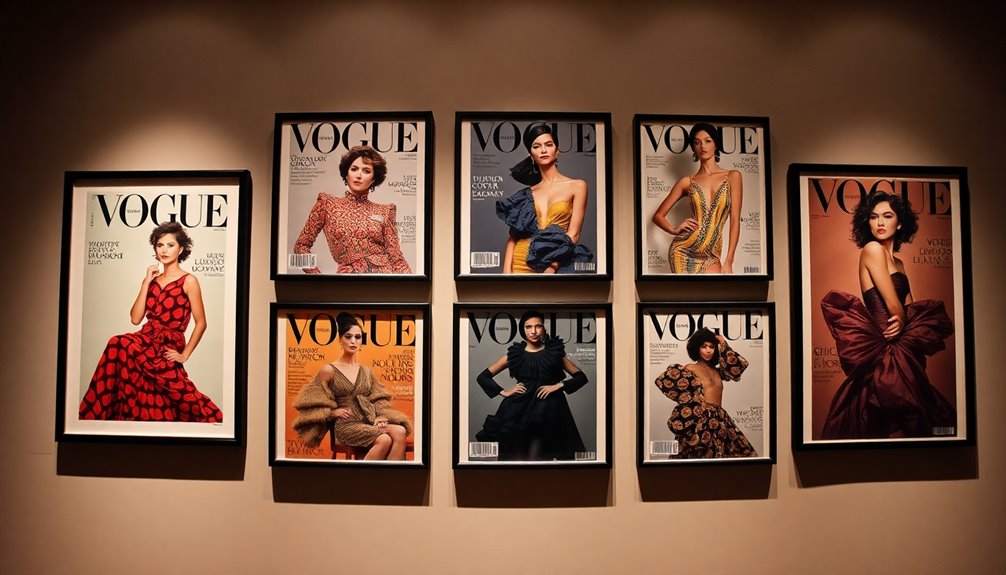
In recent years, the conversation around gender and fashion norms has gained significant momentum, challenging traditional boundaries and expectations.
You've probably noticed how figures like Harry Styles have redefined these norms, appearing on the December 2020 cover of Vogue in a stunning Gucci gown. This moment marked a shift towards embracing androgyny and fluidity in fashion.
As you explore this evolving landscape, consider how it's influencing your own style choices.
- Increased visibility of non-binary and gender-fluid models
- Designers creating unisex collections that appeal to broader audiences
- Vogue covers featuring diverse gender identities challenging societal norms
This shift not only reflects changing attitudes but also empowers you to express your identity through fashion in new, exciting ways.
Vogue's Editorial Leadership
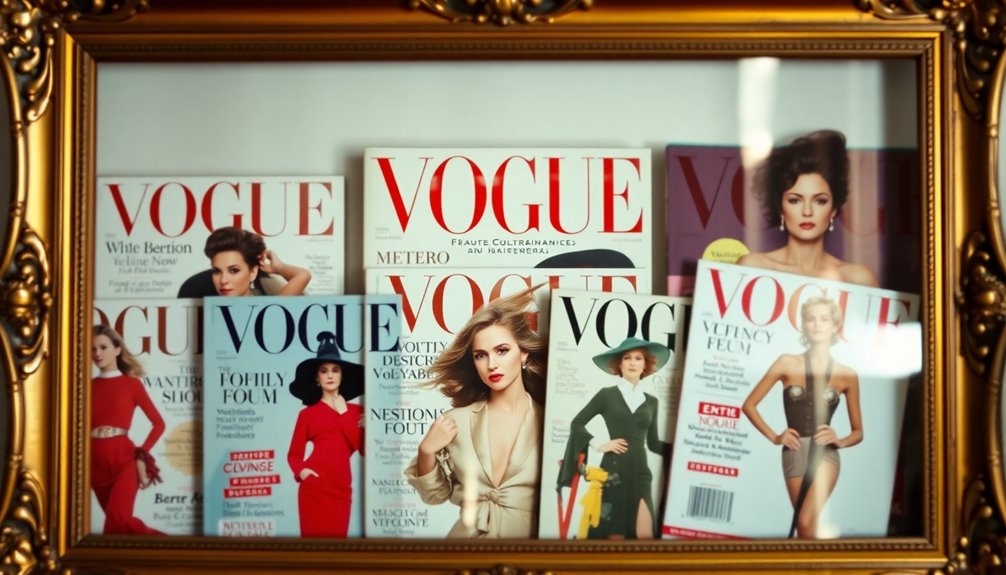
Vogue's editorial leadership has played an essential role in shaping the magazine's identity and influence within the fashion industry. From Anna Wintour's groundbreaking cover in 1988 to Edward Enninful's focus on diversity, each leader has left a unique mark. Their vision has not only transformed covers but also expanded representation in fashion.
| Leader | Key Contribution | Impact |
|---|---|---|
| Anna Wintour | Blended high and low fashion | Set new standards for covers |
| Edward Enninful | Increased diversity within editorial teams | Boosted digital traffic by 51% |
| Grace Coddington | Emphasized storytelling in fashion editorials | Elevated visual narratives |
| Carine Roitfeld | Introduced bold, edgy aesthetics | Influenced global fashion trends |
| Franca Sozzani | Advocated for cultural conversations | Challenged fashion norms |
Fashion Trends and Influence

Through its influential covers and editorial choices, Vogue has set trends that resonate across the fashion industry. You'll notice how each issue introduces new styles, inspiring designers and consumers alike.
Vogue not only showcases the latest aesthetics but also collaborates with emerging talents to shape future collections. Its role as a trendsetter acts as a barometer for popular culture, adapting to reflect contemporary tastes.
- Introduces groundbreaking styles that redefine fashion norms.
- Highlights seasonal trends that influence both high fashion and street style.
- Serves as a platform for diverse voices, pushing the boundaries of conventional fashion.
Digital Transformation of Vogue
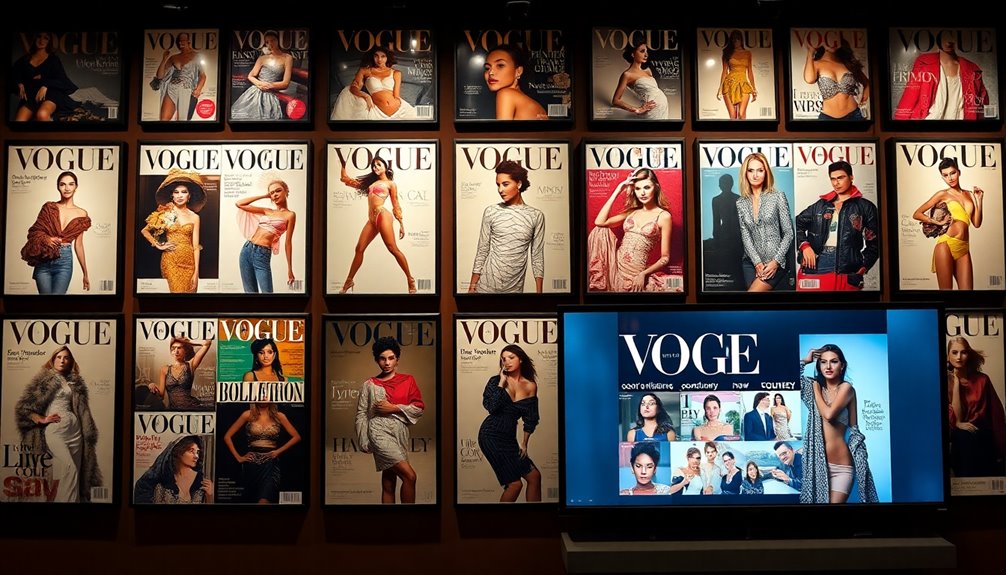
A significant shift has taken place as Vogue embraced digital platforms, responding to the changing landscape of media consumption.
You'll notice how the magazine expanded its reach through online editions, tapping into social media to engage younger audiences.
By leveraging these platforms, Vogue creates interactive content that resonates with today's readers, making fashion more accessible.
You see behind-the-scenes moments, live events, and real-time updates that keep you connected to the latest trends.
This digital transformation has allowed Vogue to maintain relevance in an increasingly fast-paced world.
As a result, you now experience a blend of traditional editorial excellence with modern engagement strategies, ensuring that Vogue continues to shape fashion discussions across diverse audiences.
Controversies and Discussions

As Vogue adapts to digital platforms, it also faces the complexities of contemporary fashion discussions. The magazine often finds itself at the center of controversies, sparking debates about representation and inclusivity.
When certain covers or themes challenge societal norms, they can ignite passionate conversations about beauty standards and cultural sensitivity.
- Some covers are criticized for lacking diversity, prompting calls for change.
- The use of certain models can evoke discussions about body positivity and representation.
- Vogue's willingness to push boundaries often leads to backlash, revealing the industry's evolving landscape.
These controversies highlight the ongoing struggle between fashion and societal expectations, making Vogue a pivotal player in shaping modern fashion discourse.
Tribute and Legacy
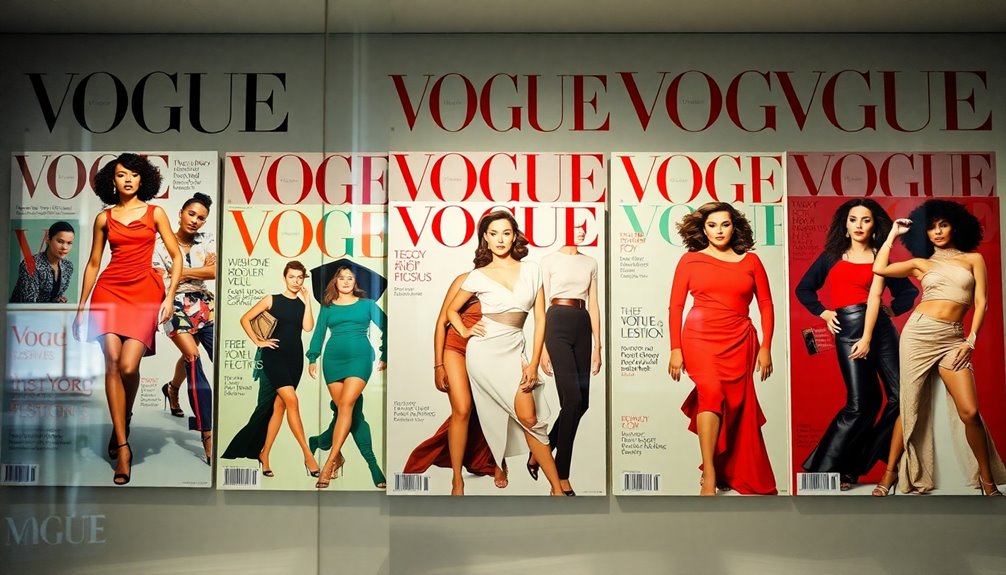
Vogue's legacy is deeply intertwined with the creative visionaries who've shaped the fashion landscape, and one of the most influential figures has been Karl Lagerfeld. His innovative designs and striking aesthetics left an indelible mark on the industry, and his numerous covers for Vogue celebrated not just fashion, but the artistry behind it.
You can't overlook how his iconic imagery and bold statements challenged norms, inspiring countless designers and fashion enthusiasts alike. Lagerfeld's ability to blend classic elegance with modern flair resonated globally, ensuring his influence persists.
As you reflect on Vogue's history, remember how Lagerfeld's legacy continues to inspire new generations, pushing the boundaries of style and creativity in ways that redefine fashion.
Frequently Asked Questions
How Has Social Media Influenced Vogue Cover Trends?
Social media's transformed how you view and interact with fashion.
It's created instant feedback loops, allowing trends to emerge rapidly and influencing what makes a compelling cover. You see diverse models and themes, reflecting real-world conversations around inclusivity.
Platforms like Instagram amplify these visuals, making them more accessible.
As a result, Vogue adapts by showcasing fresh aesthetics and engaging with a wider audience, keeping its relevance in the ever-evolving fashion landscape.
What Are the Most Iconic Vogue Covers of All Time?
Like a flash of lightning, iconic Vogue covers illuminate fashion history.
You can't ignore the impact of covers featuring models like Twiggy, Naomi Campbell, and Audrey Hepburn, each capturing a unique cultural moment. Their presence not only inspired trends but sparked conversations about beauty and representation.
You'll find that these covers have shaped societal standards and left an indelible mark on the fashion landscape, making them unforgettable pieces of art in their own right.
How Often Does Vogue Change Its Editorial Direction?
Vogue changes its editorial direction periodically to stay relevant and reflect current trends.
You'll notice shifts often align with cultural movements, societal changes, and the evolving fashion landscape.
Each new editor brings fresh perspectives, influencing the magazine's content and visual style.
This adaptability keeps it at the forefront of fashion journalism, ensuring it resonates with both long-time readers and new audiences.
It's this dynamic approach that maintains Vogue's status as a fashion authority.
Who Decides Which Models Appear on the Covers?
Did you know that 25% of the editorial team at British Vogue comprises people of color?
When it comes to deciding which models appear on the covers, a collaborative effort takes place. Editors, creative directors, and photographers work together to select models that align with the magazine's vision and current trends.
Ultimately, these choices reflect broader cultural conversations around diversity and representation in fashion, making each cover a significant statement.
What Role Do Advertisers Play in Cover Selections?
Advertisers play an essential role in cover selections by influencing the magazine's visual narrative and target audience.
When you consider the products being promoted, they often seek models who resonate with their brand image. This creates a partnership where your choices as a reader are shaped by the advertisers' desires.
Ultimately, the balance between editorial vision and advertising needs can dictate which models grace the covers you see each month.
Conclusion
As you can see, Vogue covers aren't just about fashion; they're a mirror reflecting society's evolving values. Did you know that since 1966, when Donyale Luna became the first Black model on the cover, more than 40% of Vogue's covers now feature models of color? This shift highlights the magazine's commitment to diversity and inclusion. By celebrating these pivotal moments, you're not just witnessing fashion history; you're engaging with a narrative that continues to shape our world today.


